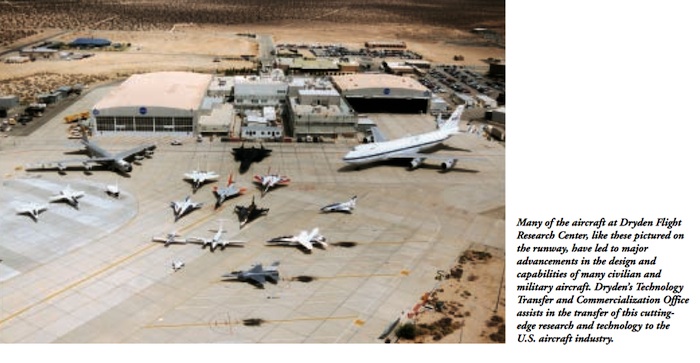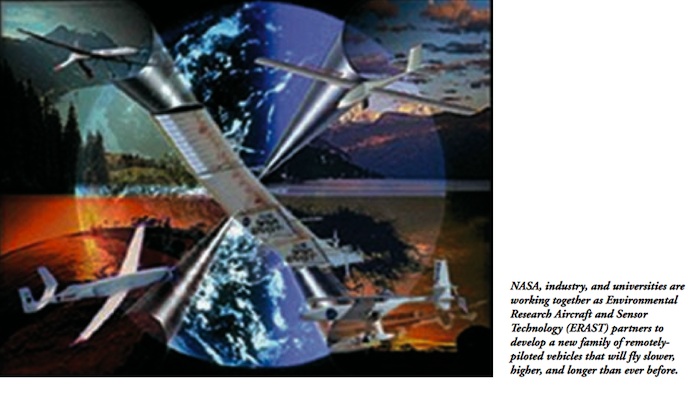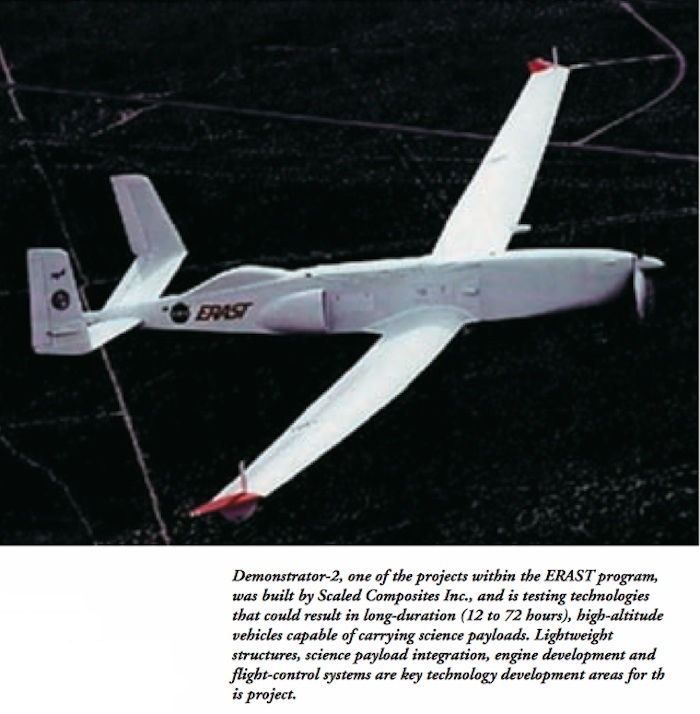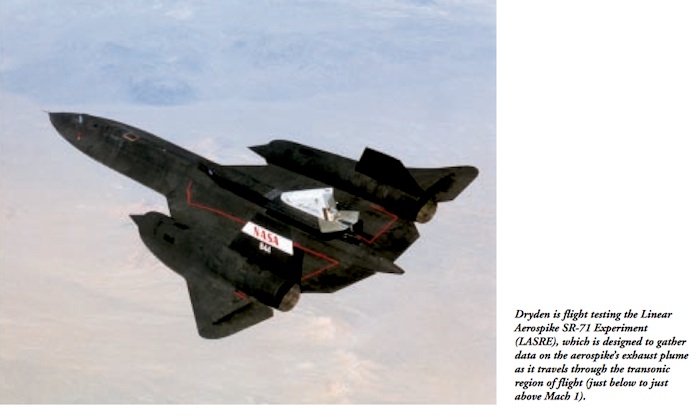.

In March 1994, Dryden Flight Research Center became a full-fledged field center. As a result of attaining center status, Dryden’s Technology Transfer and Commer- cialization (T2) office was officially created in May 1995. The T2 office is now part of the “PACE” group, which consists of Public Affairs, Commercialization, Education, and History.
As NASA’s primary installation for flight research over the last fifty years, Dryden projects have led to major advancements in the design and capabilities of many civilian and military aircraft. The T2 staff work closely with a variety of clients, from large aircraft companies to small business owners from the start, to ensure that the technologies tested and developed at the center can be directly integrated by its customers.
The T2 staff developed their own guidelines and work closely with the researchers and engineers at the center to capture Dryden’s unique innovations. Aeronau- tics research at the center results in technical papers, the essence of which are captured in NASA’s TechTracS database. The T2 staff also work in tandem with the Research Engineering, Projects and Facilities directorates to determine which innovations should be protected by patents.
In addition, the staff work closely with contracting managers’ technical representatives to determine what technologies have been developed as a result of contracts, grants, and Small Business Innovation Research (SBIR) contracts. This cooperation resulted in many new patents and a faster transfer of new technologies to U.S. industry. To facilitate new technology reporting, the T2 staff encourage the companies to write articles for NASA Tech Briefs, and follow up with press releases to help launch the companies’ new innovations.
Striving to meet the aggressive goals set forth by Administrator Dan Goldin in NASA’s Strategic Vision, the following projects and partnerships provide an overview of Dryden’s role in meeting NASA’s goals. This roadmap for the future is outlined and best illustrated by the “Aeronautics and Space Transportation Technology: Three Pillars for Success.”
Pillar One: Global Civil Aviation
To preserve the nation’s economic health and the welfare of the traveling public, the first pillar focuses on safety, environmental compatibility, and affordable air travel. Dryden’s first goal is to reduce the aircraft accident rate by a factor of five within ten years and by a factor of ten within twenty years. To meet the challenge, current
innovations and programs include the patented Propul- sion-Controlled Aircraft, the Structural Health Monitor- ing System on Systems Research Aircraft for X-33, and the Lidar Clear Air Turbulence Measurement, developed under an SBIR contract by Coherent Technologies.
The innovative work of reducing emissions of future aircraft by a factor of three within ten years, and five within twenty years, is ongoing. In addition, a new family of remotely-piloted vehicles (RPVs) that fly slower, higher, and longer are being developed. These long-duration, high-altitude RPVs could be used in upper-atmosphere science missions to help collect, identify, and monitor environmental data to assess global change. They could also carry telecommunications equipment to high altitudes, serving much like satellites for a fraction of the cost of putting traditional satellites in space.
The Environmental Research Aircraft and Sensor Technology (ERAST) partnership has yielded significant technological advancements to meet the second goal of the first pillar—environmental compatibility. Besides Dryden, three other NASA research centers (Ames, Langley, and Lewis), along with The Association for Unmanned Vehicle Systems International, American Technology Initiatives Inc., Thermo Mechanical Systems Inc., and several universities are included as partners. The major industry partners are listed below in parentheses, after the names of the unpiloted aircraft, which are products of the ERAST partnership.
• Pathfinder (AeroVironment Inc.) is a proof-of- concept vehicle for two more prototype solar- powered aircraft that have the ability to study the upper atmosphere without disturbing it. Remote monitoring of storm developments, forests, and crop damage are also benefits.
• Apex (Advanced Soaring Concepts, Inc.) is used to validate high-altitude testbed aircraft design methodologies by measuring airfoil characteristics at low Reynolds numbers and high subsonic
Mach numbers in a low-turbulence environment. • Perseus B (Aurora Flight Sciences Corp.) involves
test engine concepts, lightweight structures, science payload integration, and fault tolerant flight control systems.
• Altus (General Atomics Aeronautical System Inc.) verifies technologies that lead to a long-duration, high-altitude vehicle that could carry science payloads.
• Demonstrator-2 (Scaled Composites Inc.) centers on over-the-horizon communication capabilities, lightweight structures, science payload integration, engine development, and flight control systems.
The second goal is to reduce the perceived noise levels of future aircraft by a factor of two from today’s subsonic aircraft within ten years, and by a factor of four within twenty years. Dryden is currently flying the SR-71 aircraft, on loan from the U.S. Air Force, to study sonic


boom propagation. Data from the SR-71 high speed research program will be used to aid designers of future supersonic/ hypersonic aircraft and propulsion systems, including a high speed civil transport.
.

The final goal is affordable air travel. While maintaining safety, Dryden strives to triple the aviation system throughout, in all weather conditions within ten years. Reducing the cost of air travel by twenty-five percent within ten years and by fifty percent within twenty years, is being accomplished by Orbital Sciences’ patented Adaptive Performance Optimization, Electro Hydrostatic Actuator, the Fiber Optic Position Measurement Network, and the Smart Actuator, which reduces wire weight by sixty percent and detects its own internal failures; thereby reducing maintenance costs.
.
Pillar Two: Revolutionary Technology Leaps
NASA’s objective outlined in the second pillar is to explore high-risk technology areas that can revolutionize air travel and create new markets for U.S. industry. The technology challenges for NASA include: eliminating the barriers to affordable supersonic travel, expanding general aviation, and accelerating the application of technology advances.
The first technology goal is to reduce the travel time to the Far East and Europe by fifty percent within twenty years, and to do so at today’s subsonic ticket prices. To break the barriers to high speed travel, Dryden has imitated several programs including the TU-1 44LL Initiative.
The Russian TU-144LL supersonic transport is being used as a flight research test vehicle to conduct experi- ments which will enhance the development of advanced technology necessary to build the next generation high speed civil transport. The purpose of the program is threefold: develop and transfer supersonic airliner technology directly to U.S. aircraft industry under NASA sponsorship; establish a working relationship between U.S. and former Russian aircraft manufacturers at
programmatic and technical levels; and acquire flight research data and existing operational experience to narrow the margin of European supersonic transport experience gained from the Concorde.
Dryden is also dedicated to providing next-genera- tion design tools and experimental aircraft to increase design confidence and cut the development cycle in half. This goal is being accomplished through several programs including: the Hyper-X program, which will demonstrate hypersonic propulsion technologies; the X-36 Tailless Fighter Agility Research Aircraft, a remotely-piloted jet designed to fly without traditional tail surfaces aimed at improving the maneuverability and survivability of future fighter aircraft; and the Linear Aerospike SR-71 Experi- ment (LASRE), designed to gather data on the aerospike’s exhaust plume as it travels through the transonic region of flight (just below to just above Mach 1).
Pillar Three: Access to Space
Finally, low-cost space access is essential to unleash- ing the commercial potential of space and greatly expand- ing space research and integration. NASA’s primary space transportation technology role is to develop and demon- strate pre-competitive, next-generation technology that will enable the commercial launch industry to develop full-scale, highly competitive, and reliable space launchers.
Dryden is pushing ahead with two programs with objectives to meet the goal of this last pillar. First, in partnership with Lockheed-Martin in the X-33 program, Dryden aims to reduce the payload cost to low-Earth orbit by an order of magnitude, from $10,000 per pound within ten years. Second, in partnership with Kelly Aerospace, the Eclipse program goal is to reduce the payload cost to low-Earth orbit by an additional order of magnitude, from thousands to hundreds of dollars per pound, by the year 2020.
The flight research programs initiated at Dryden help move the U.S. aircraft industry closer to achieving its goals. And everyday the efforts of the Technology Transfer and Commercialization office take Dryden Flight Research Center one step closer to realizing its vision statement: “The world leader in flight research for discovery, technology development, and technology transfer for U.S. aeronautics and space preeminence.”
.

Quelle: Technology Transfer and Commercialization / NASA
4047 Views
